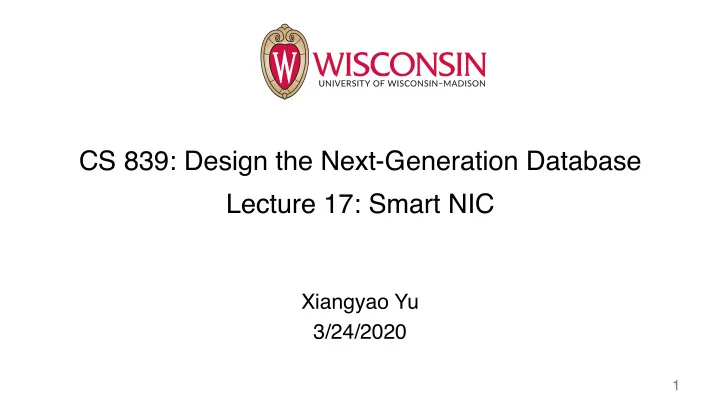

CS 839: Design the Next-Generation Database Lecture 17: Smart NIC Xiangyao Yu 3/24/2020 1
Announcements Feedback on project proposals will be provided this week Upcoming deadlines • Paper submission: Apr. 23 • Peer review: Apr. 23 – Apr. 30 • Presentation: Apr. 28 & 30 2
Discussion Highlights Active memory without in-order delivery? • Assign seq number to each packet and resemble at the receiving side Active Memory vs.Write Behind Logging? • Both use “force” instead of “no-force” • Can be combined (single- vs. multi-versioning) • Keep data in persistent memory in Active Memory Other examples of increasing computation to reduce network overhead • Caching • Data centric computing (moving computation to data) • Compression and decompression • Directory-based cache coherence: unicast vs. multicast 3
Today’s Paper SIGCOMM 2019 4
Kernel Bypass Kernel bypass (DPDK and RDMA) Conventional network stack 5
Kernel Bypass Kernel bypass (DPDK and RDMA) Conventional network stack Pushing computation to storage => Smart SSD Pushing computation to network => Smart NIC 6
Smart NIC Architecture Network Traffic 7
Smart NIC Architecture Network Traffic 8
Smart NIC Architecture Network Traffic 9
Smart NIC Architecture Network Traffic 10
On-path vs. Off-path On-path: NIC cores handle all traffic on both send & receive paths 11
On-path vs. Off-path On-path: NIC cores handle all traffic on both send & receive paths Off-path: Host traffic does not consume NIC cores 12
SmartNIC Specifications on-path off-path • Low power processor with simple micro-architecture 13
On-Board Memory 1. Scratchpad/L1 2. Packet Buffer (only for on-path) • Onboard SRAM with fast indexing 3. L2 cache 4. NIC local DRAM (4GB – 8GB) 5. Host DRAM (accessed through DMA) 14
Performance Characterization 15
Bandwidth vs. Core Count 10 GbE LiquidIO II CN2350 25 GbE Stingray PS225 • Echo server • Packet transmission through a Smart NIC core incurs nontrivial cost • Packet size distribution impacts availability of computing cycles 16
Bandwidth vs. Packet Processing Cost 10 GbE: LiquidIO II CN2350 25 GbE Stingray PS225 • Processing headroom is workload dependent and only allows for execution of tiny tasks 17
Average and P99 Latency 10 GbE LiquidIO II CN2350 • Achieving maximum throughput using 6 and 12 cores • Hardware support reduces synchronization overheads 18
Send/Recv Latency 10 GbE LiquidIO II CN2350 • Special accelerators for packet processing • Send/recv Latency lower than RDMA or DPDK 19
Host Communication • DMA latency is 10X higher than DRAM latency in host cores • 1-sided RDMA latency is higher than DMA latency 20
iPipe Framework 21
Actor Programming Model Object-oriented programming • Encapsulation : internal data of an object is not accessible from the outside 22
Actor Programming Model Object-oriented programming • Encapsulation : internal data of an object is not accessible from the outside • Calls to different objects executed by the same thread 23
Actor Programming Model Object-oriented programming • Encapsulation : internal data of an object is not accessible from the outside • Calls to different objects executed by the same thread • Must handle concurrent accesses 24
Actor Programming Model Object-oriented programming Actor programming model • Encapsulation • An Actor has its local private states • Actors communicate through messages 25
Advantages of Actor Model Actor model supports computing heterogeneity and hardware parallelism automatically Actors have well-defined associated states and can be migrated between the NIC and the host dynamically 26
iPipe Scheduler Migration steps 1. Remove from runtime dispatcher 2. Actor finishes execution 3. Moves objects to host 4. Forwards buffered requests to host 27
Distributed Memory Object (DMO) All pointers replaced by object IDs 28
Security Isolation Actor state corruption: • Problem: Malicious actor manipulating other actors’ states • Solution: Paging mechanism to secure object accesses Denial of service: • Problem: An actor occupies a SmartNIC core and violates the service availability of other actors • Solution: Timeout mechanism 29
Applications on iPipe 30
Replicated Key-Value Store Log-structured merge tree for durable storage Replication using Multi-Paxos Actors: 1. Consensus actor 2. LSM Memtable actor 3. LSM SSTable read actor 4. LSM compaction actor 31
Distributed Transactions Phase 1: read and lock Phase 2: validation Phase 3: log by coordinator Phase 4: commit Actors: 1. Coordinator 2. Participant 3. Logging actor 32
Real-Time Analytics Analytics over streaming data Actors: 1. Filter 2. Counter • Sliding winder and periodically emit tuple to the ranker 3. Ranker • Sort to report top-n 33
Evaluation – Busy CPU Cores • Host CPU cycles are saved • Offloading adapts to workload 34
Evaluation – Latency vs. Throughput 35
Evaluation – iPipe Overhead Replicated Key-Value Store Overhead 1: DMO address translation when accessing objects Overhead 2: Cost of iPipe scheduler 36
Smart NIC – Q/A Actor Model in detail Compare to RMA based approaches as defined in SNAP (SOSP’19)? Are SmartNICs widely used nowadays and where? Can transactional databases benefit from SmartNIC? Limitation of SmartNIC (cost?) Side-channel attacks? Offloading control-intensive complex workloads to SmartNICs a promising path? 37
Group Discussion SmartNIC pushes computation to network while SmartSSD pushes computation to storage. What are the main differences in terms of opportunities and challenges between the two technologies? What database operations should be pushed to SmartNIC? Please discuss OLTP and OLAP separately. One can consider processors in a Smart NIC as extra heterogeneous cores in a system. What extra benefits do we get by putting these extra cores into the NIC (in contrast to putting them close to storage or CPU)? 38
Before Next Lecture Submit discussion summary to https://wisc-cs839-ngdb20.hotcrp.com • Deadline: Wednesday 11:59pm Next lecture will be given by Dr. Mike Marty from Google 39
Recommend
More recommend